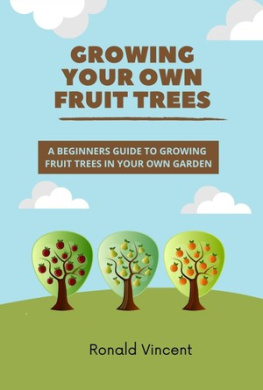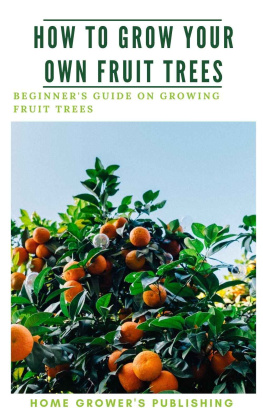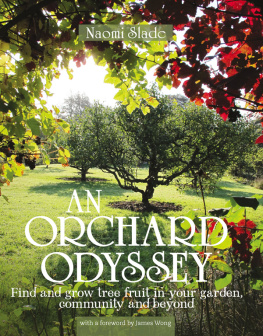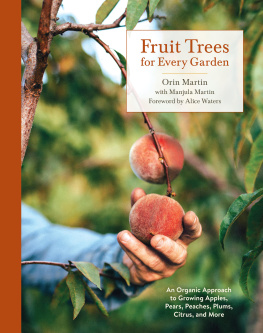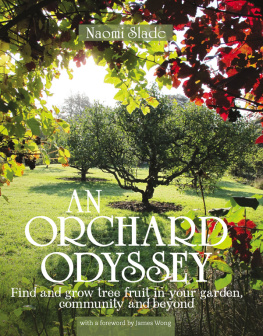Acknowledgements
First and foremost, I want to thank Sherry Firing and Lynn Nicholas, the two amazing women who have worked tirelessly with me to create and maintain Ben Nobleman Park Community Orchard. As our Head Gardener, Sherry has spent hours leading us in our gardening activities, creating harvest festival posters and painting a mural on our orchard shed. As our volunteer coordinator and administrator, Lynn has dedicated hours of her time organizing our stewardship days, working in the park, and keeping our orchard and our group, Growing for Green, running smoothly.
Nothing would have been possible without the more than 20 hands-on volunteers who have poured their love and energy into our park and our orchard through weeding, planting, watering, mulching, helping with festivals and community events, website development and design, writing blogs, copyediting and more. It is your work and care that will help keep our message going and keep our trees strong and productive over the years.
Our city councillor, Joe Mihevc, and his wonderful staff supported us in our dream to create Torontos first community orchard in a public park. Chris Martin, horticultural supervisor of the City of Torontos Parks, Forestry and Recreation, always had time for us and helped us develop and carry out our proposal. Other wonderfully supportive Parks, Forestry and Recreation staff included Brian Green, Diane Tomlin and Sandy Straw.
Thank you to our instructors and mentors; Norm Herbert, former orchard manager of E.D. Smith Farms, Ken Slingerland, retired soft fruit expert from the Ontario Ministry of Food and Rural Affairs, and articling agrologist Ray Martinez. They have been there for us in so many ways. Other orchardists who generously shared their knowledge with me are Lorne Jamieson, field manager of Ignatius Farm Jesuit Centre in Guelph, Ontario, Gaye Trombley of Avalon Orchards in Innisfil, Ontario, and Kent Mullinex of The Sharing Farm in Richmond, B.C. And our wonderful fig tree expert, Steve Biggs, not only taught one of our popular workshops but also spent hours poring over this book to offer his suggestions and advice. Thanks as well to my instructor at Ryerson University, ecologist and native tree expert Sam Benvie. He was the first to awaken my passion for trees in general and how much they contribute to our environment.
The funding for our orchards activities and infrastructure came from generous financial and in-kind contributions from Live Green Toronto, City of Toronto Economic Development, Walmart-Evergreen, Carrot Cache, Fiskars Tools, Richters Herbs, Gro-Bark, Green Garage and the Toronto Parks and Trees Foundation. Thanks to their support we have achieved so much in just a few years. Partnering with the Catalyst Centre One-Stop Pop-Ed Shop Worker Co-op has allowed us to accept these grants. Thank you to Catalyst board members for taking us on!
We are very grateful for our fantastic partners. Not Far from the Tree, founded by Laura Reinsborough, is our harvest partner. Local Enhancement and Appreciation of Forests (LEAF), founded by Janet McKay, has partnered with us for festivals and workshops. Laura and Janet and their teams have promoted our activities, offered us advice and invited us to collaborate on popular events such as the annual Edible Tree Tour. Another wonderful educational partner has been Andrea Dawber and her charity GreenHere. She has offered me advice and support in so many ways.
My inspiration in founding a community orchard was fuelled by the success of other initiatives in North America. In 2010, I was visiting British Columbia and Mary Gazetas, of The Sharing Farm, offered to show me around her groups newly planted orchard in Richmond, B.C. Sadly, Mary died unexpectedly in 2012 and is very much missed. I am grateful to Kimi Hendress, the Sharing Farms Orchard Manager, for keeping me up to date on their activities. Alison Pultinas, who was involved in Earthworks Boston, gave me a tour of that citys well-established community orchards in 2011. And Bob Baines, of Seattles Parks Department, dazzled me in 2012 with the blossoming orchards of his city. Seattles food policy and support for urban growing is an inspiration to cities around the world.
I have yet to visit the orchards of the United Kingdom, but I am grateful to the founders of Common Ground. Their Community Orchard Handbook showed me what was possible when it comes to creating orchard projects in a community. And who gave me that book? Landscape architect Jane Hutton, who volunteered to help us create a design for our orchard to present at community meetings. Without being able to illustrate what we were trying to create, we might not have been given the green light at all. Thank you, Jane!
Today my inspiration comes from the ambitious groups in Toronto that are now following in our footsteps and planting their own orchards. I love working with North York Community House and its Family Tree Project, and with the team at Shoresh, who have recently planted an orchard on donated land at Bela Farm. And I look forward to growing alongside the new orchards of Malvern ANC and the Toronto French School and many other groups.
Thank you as well to the many people who have made creative contributions to our orchard and to our organization, including Tania Janthur, of Bungalow Design, who has created many posters and logos for us over the years. Jack Kirchhoff has copy edited various incarnations of this book and Stephen Grenon has supported us with his photographs, his encouragement and his French-language proficiency.
I want to thank my husband, Cliff Changoor, who is my gardening inspiration. He has been there for me during the good times and stood firmly by my side during the challenging times. When we need heavy work done in the orchard, he is always there, willing to dig out sickly but deeply rooted juniper bushes or shovel huge piles of mulch.
Finally, I want to thank my wonderful parents, Malca and Murray Poizner, who have encouraged me in all my creative initiatives. Thank you for believing in me!
Bibliography
Carlson, Robert F.
North American Apples: Varieties, Rootstocks Outlook. Michigan State University Press. 1970.
Dolan, Susan.
Fruitful Legacy: A Historic Context of Orchards in the United States. National Park Service. U.S. Department of the Interior. 2009.
Ellis, Barbara W. and Marshall Bradley, Fern.
The Organic Gardeners Handbook of Natural Insect and Disease Control,Rodale Press. 1996.
Gillman, Jeff.
The Truth About Organic Gardening: Benefits, Drawbacks and the Bottom Line. Timber Press. 2008.
Gershuny, Grace.
Start with the Soil: The Organic Gardeners Guide to Improving Soil for Higher Yields, More Beautiful Flowers, and a Healthy, Easy-Care Garden. Rodale Press. 1993.
Hill, Lewis and Perry, Leonard,
The Fruit Gardeners Bible: A Complete Guide to Growing Fruits and Nuts in the Home Garden. Storey Publishing. 2011.
Martin, Carol.
The Apple: A History of Canadas Perfect Fruit McArthur and Company. 2007.
McMorland Hunter, Jane and Kelly, Chris.
For the Love of an Orchard: Everybodys Guide to Growing & Cooking Orchard Fruit. Pavilion. 2010.
Otto, Stella.
The Backyard Orchardist: A Complete Guide to Growing Fruit Trees in the Home Garden. OttoGraphics. 1993.
Phillips, Michael.
The Apple Grower: A Guide for the Organic Orchardist. Chelsea Green. 2005.
Phillips, Michael.
The Holistic Orchard: Tree Fruits and Berries the Biological Way. Chelsea Green. 2011.
Reich, Lee.
Next page


